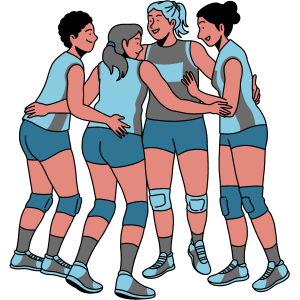Most of us are familiar with the physical aspects and impact of injuries and how to address them. We apply ice when something is painful, wear a brace when something feels unstable and seek out help from a professional. But what about the psychological impact of injuries on our mental wellbeing?
Injuries affect us mentally as much as physically. Injuries can render us unable to participate in our sport or hobby and remove us from our regular social activities. Often this results in depressive symptoms, such as sadness, difficulty concentrating and restless sleep. Many people also fear losing their strength and skills when they are injured due to time lost training, which also takes a mental toll. We may feel helpless, but fortunately there are actions we can take and techniques we can use to not only reduce the impact on our mental health but also maintain strength and skill.
The first action I always recommend people take is to stay involved with your team or activity group. Go to games and practices and participate where possible to stay involved and connected. Players or participants on the sidelines can still play an important role in the success of the team. For example, in hockey, you can open the gates, keep the waters filled and help with equipment malfunctions. You can provide another eye to watch for delayed penalties and help with strategic play. There may be some drills or some skills you can still work on in practice, and help organize and run drills when not possible. Many activities involve a social event post-game, such as golf. Joining your group after a round is a great way to stay involved and feel connected even if you were unable to participate.
Another incredibly effective technique for maintaining skills is imagery.Before we go any further, it’s important to differentiate imagery from visualization. Visualization is the act of imagining or watching yourself do something, either from an internal or external viewpoint. Imagery, on the other hand, involves incorporating all of your senses and internally experiencing the action, including the sights, smells, sounds, tastes and physical feelings. Imagery on its own is a skill and does take practice to become proficient at. You can use imagery to practice specific skills or techniques, and it can strengthen and maintain neuromuscular pathways allowing you to stay proficient at a movement even if you cannot physically practice it.Imagery isn’t restricted to when you’re injured or even for sport. You can use it anytime to help improve proficiency in skills and to rehearse before a performance or presentation.
The cross-education phenomenon through contralateral training is a third way in which you can reduce both the mental and physical effects of an injury. The cross-education phenomenon refers to the strength transfer you can achieve in one limb by training the other, or contralateral, limb. For example, if you are healing from an ACL reconstructive surgery in your left knee but you continue to train the right knee and leg, some of the strength gains in the right will actually transfer to your left knee via the nervous system. Contralateral limb training while injured can help reduce the deficits and maintain some strength and stability in the injured limb.
If you’re healing from an injury, don’t underestimate the psychological impact it can have. Even with the most severe of injuries there is always something we can do. Contact me today to get back on the road to recovery!
Crystal Bartkowski,
Certified Athletic Therapist

